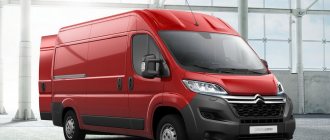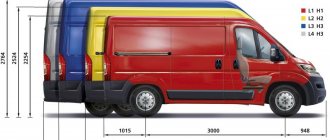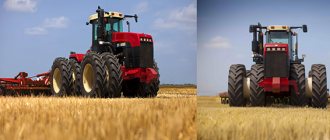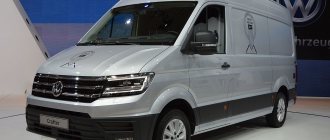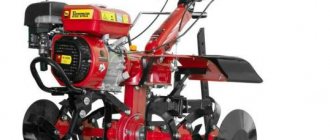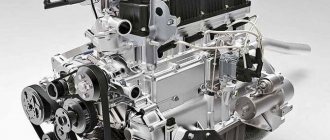Rated fuel consumption is one of the most informative and important characteristics of a car for the driver. This is what manufacturers often use to advertise and promote a particular new car model.
Among owners of used cars, it is considered acceptable to consume up to 10 liters of gasoline or diesel per 100 kilometers. In foreign countries, this indicator is indicated in miles, so recalculation into “native” units is often necessary. The fuel consumption tables available in this section of the site are considered very useful.
What does the fuel consumption indicator indicate? What does this characteristic mean? We are talking about hydrocarbon fuel consumption. For example, for an SUV the figure corresponds to 9.5 liters per 100 km. It is quite acceptable, primarily due to the weight and power of the car. The indicator can be reduced due to the following:
- use of energy recovery systems during braking;
- lightening the weight of the car when replacing body and chassis elements with innovative materials;
- engine improvements;
- replacing the exhaust system.
For new models, consumption of 6 l/100 km is considered quite a “cruising” figure, but it will be higher for heavy SUVs and pickups and lower for small hybrids. The necessary information can be found in the tables provided.
What to do if fuel consumption is higher than rated? If the car consumes more fuel and does not correspond to the nominal value indicated in the table, this means there is a malfunction. Experienced service center technicians will tell you how serious it is and how it can be eliminated. In some cases, tuning makes it possible to further optimize fuel consumption, but this is usually achieved by lightening the body structure or by replacing the engine. Professional automotive technicians can provide specific recommendations.
Fuel consumption of the Citroen Jumper ranges from 7.4 to 12.8 liters per 100 km.
Citroen Jumper is available with the following fuel types: Diesel fuel, AI-95 gasoline.
Fuel consumption Citroen Jumper restyling 2014, flatbed truck, 2nd generation
| Engine capacity | Power | Transmission | Drive unit | Fuel | Consumption |
| 2.2 l | 150 hp | Manual transmission | front-wheel drive | Diesel fuel | 7,4 |
| 2.2 l | 130 hp | Manual transmission | front-wheel drive | Diesel fuel | 7,4 |
Citroen Jumper engines. Official fuel consumption per 100 km.
Van, 1994-2002
Diesels:
- 1.9, manual transmission, 69 l. With.
- 2.0, manual transmission, 110 l. With.
- 2.5, manual transmission, 86 l. With.
- 2.5, manual transmission, 107 l. With.
Minibus, 1994-2002
Diesels:
- 1.9, manual transmission, 69 l. With.
- 2.0, manual transmission, 110 l. With.
- 2.5, manual transmission, 86 l. With.
- 2.5, manual transmission, 107 l. With.
- 2.8, manual transmission, 127 l. With.
- 2.8, automatic transmission, 127 l. With.
Van (2002-2006)
Diesels:
- 2.0, manual transmission, 84 l. With.
- 2.0, manual transmission, 110 l. With.
- 2.8, manual transmission, 127 l. With.
Minibus (2002-2006)
Diesels:
- 2.0, manual transmission, 84 l. With.
- 2.0, manual transmission, 110 l. With.
- 2.8, manual transmission, 127 l. With.
- 2.2, manual transmission, 100 l. With.
Van (since 2007)
Diesels:
- 2.2, manual transmission, 100 l. With.
- 2.2, manual transmission, 120 l. With.
- 3.0, manual transmission, 157 l. With.
Minibus (since 2007)
Diesels:
- 3.0, manual transmission, 157 l. With.
The engine does not start when the battery is working
In 2015, the updated Citroen Jumper was presented; the range of engines was improved, they became 15 more economical, but the layout remained the same; power plants of 2.2 and 3.0 liters are available. You need to understand that critical wear is caused by untimely elimination of problems of related mechanisms, overloads, contamination of the fuel or air filter, and the use of low-quality lubricant.
Typical breakdowns
1) Citroen Jumper stalls
This problem is often related to the fuel pressure regulator. Owners of a van with a P.22DTE engine sometimes complain about difficulties starting when cold; they have to play with the gas pedal, holding about 1000 rpm, otherwise the engine will stall. We advise you to check the glow plugs, compression, air flow meter. If no problems are identified, proceed to cleaning or completely replacing the injection pump pressure regulator.
2) The engine emergency mode turns on - CHECK lights up due to problems with the cooling fan
To carry out repairs, it is necessary to test the relays that are responsible for the operation of the fans. The technicians run the fans directly to check their serviceability and wiring integrity. This is painstaking work, so it is advisable to contact trusted specialists. But emergency mode can also be activated in other cases (here you need to look specifically at the error code).
3) Problems with injectors
The injectors become clogged and do not flow diesel fuel well, causing the engine to run intermittently and consumption to increase. This also negatively affects the life of the Citroen Jumper engine. Therefore, proper adjustment, repair (restoration of spray) or replacement is necessary. For in-place repair of nozzles and plunger pairs, the composition RVS-Master Injection Pump Dp3 is suitable. Flushing cleans the working surfaces of the injectors and the combustion chamber from resins and carbon deposits. After treatment, the pressure in the system increases, and a protective layer of metal-ceramic is formed on the working surfaces of the injection pump, atomizer, and back pressure valve. Thanks to the restoration of plunger pairs, engine starting is simplified and fuel savings reach 15%.
Reasons for high fuel consumption
If we talk about increased fuel consumption on the Citroen Jumper, there are a number of reasons. Which can be divided into technical and operational.
The main technical problems due to which fuel consumption increases:
- Engine malfunction.
- Incorrectly configured ignition, clogged injector or other elements of the fuel system.
- Incorrect operation of the electronic engine control system (most often due to a failed sensor).
- A burnt out or clogged catalyst, in addition to increasing consumption, greatly affects the loss of power.
- Broken spark plugs.
- Clogged injectors.
- Clogged air and fuel filter.
- Worn clutch or automatic transmission.
- Malfunctions of the brake system.
- Tire wear or low tire pressure.
Operational nuances that may result in increased consumption:
- A sporty driving style with sharp accelerations, in which the engine has to operate at higher speeds.
- Large vehicle loads, also towing a trailer and using a roof rack.
- Filling the car with low-quality fuel.
- The use of motor and transmission oils of higher viscosity than the manufacturer recommends.
- Driving on a cold engine.
- Incorrect choice of wheel or rim size.
- Driving with energy consumers turned on and air conditioning running.
Most of the reasons why a Citroen Jumper may experience fuel burn are trivial and lie on the surface. But some problems may require professional diagnostics to determine.
In some cases, to achieve normal flow, it is necessary to carry out a number of repair or preventative actions. In which, all problem areas will be checked step by step, and errors will be eliminated.
PURPOSE
The Citroen Jumper series includes many modifications and designs, which makes the scope of use of the car quite extensive. The main direction of operation involves the transportation of people and goods over short and medium distances. The model is especially popular among small companies, due to its relatively low cost and ease of maintenance. At the same time, the Citroen Jumper cannot be called an exclusively commercial car, since some modifications are used as family transport.
COMFORTABLE SALON
At the top of the center console there is a tablet on which you can conveniently place documents or your smartphone.
Those who spend most of their working time on the road will undoubtedly appreciate the convenience of the Citroën Jumper leather steering wheel.
A well-organized office space is the key to successful work. That's why the New Citroën Jumper is equipped with a variety of carefully designed storage compartments for various items.
The gear shift lever is conveniently located on the front panel for more comfortable driving.
Front seats with armrest and lumbar support adjustment for maximum comfort when moving.
STORY
1st generation
The debut of the Citroen Jumper took place in 1994. The French manufacturer has followed a new style of naming its cars. In the brand's model range, the series replaced the Citroen C25 light-duty van. It is noteworthy that the French language does not have the word Jumper; the car got its name from the English word “Jumper”.
The design of the first generation turned out to be standard and included a relatively small front bumper, sweeping mirrors and a rectangular body shape. The model received a front-wheel drive layout, a durable chassis and a transverse arrangement of the unit. A beam on longitudinal springs was installed at the rear, and an independent spark plug suspension at the front. Initially, the Citroen Jumper was offered in a cargo-passenger version and in a van body. Then versions appeared with different cabs and chassis, allowing the installation of special superstructures. For that time, the model had a very comfortable and spacious interior.
For the Citroen Jumper 1, 4 engines were available: diesel engines with a volume of 1.9, 2.5 and 2.8 liters (joint development of specialists from PSA, Fiat and SOFIM) and gasoline units with a volume of 2 liters (developed by PSA).
In 1996, all-wheel drive versions of the Citroen Jumper appeared on the market.
1st generation restyling
In 2002, the series underwent restyling. The engine range has been revised. The previous units were replaced with 2-liter gasoline engines (110 hp) and 2- or 2.8-liter diesel units (84-146 hp). The environmental class of all engines has become an order of magnitude higher (Euro-3). The equipment of the modernized Citroen Jumper has been revised, and the list of additional options has expanded. There were relatively few design changes in the series.
The design of the restyled version has changed. The body received an original radiator grille and modern block headlights, complemented by double deflectors. The updates made the model more interesting, adding expressiveness to it. The car's interior has also been revised. The seats have become more comfortable, the quality of the finish has improved. The steering wheel has a reduced diameter, which simplifies the control process. The interior content of the modernized Citroen Jumper 1 was not inferior to the interior of a passenger car.
2nd generation
The restyled version lasted only 4 years, after which the French concern introduced the second generation of the series. The new style of the brand affected the design and interior of the car. The developers of the new Citroen Jumper tried to create both a dynamic and powerful car. In the exterior of the model, clearly highlighted wheel arches, large rear lights with a vertical arrangement and new block headlights made in the shape of a boomerang appeared. In the front area, a slightly protruding bumper of gigantic proportions stood out. The small hood of the second Citroen Jumper was made an extension of the windshield. The radiator grille has been completely redesigned and appears in a crossed-cell format. In the center was a chrome brand badge.
The Citroen Jumper became more flexible in handling and held the road perfectly. The basic version has a new braking system and ABS technology, which increases the safety of movement.
The series included a huge number of versions and spread throughout the world. The second generation Citroen Jumper is still actively used today.
2nd generation restyling
In 2014, the French concern updated its flagship. The Russian premiere of the car took place at the international motor show in Moscow. Restyling added to the car's attractiveness. The changes affected the front area, the range of power units, structural components and the interior. The new Citroen Jumper received a short hood with a hump, narrow headlights equipped with LED lights, a protruding front bumper lip and the familiar brand logo. The cube rear is retained.
The equipment of the restyled version has become an order of magnitude higher. Citroen Jumper also acquired an expanded list of equipment.
Advantages of the model
The new Citroen brand Jumper combines all the best developments of the famous manufacturer, which relate to issues of architecture, the general design of the car, the features of its body, as well as safety and ergonomics. The vehicle is characterized by ease of operation and minimal operating costs. Among the main structural and functional advantages are:
- Hinged rear doors.
- Loading width 1422 mm.
- Pneumatic rear suspension.
- Possibility of lowering the body by 14 cm.
- Driving assistance systems - ESP, ASR, Hill Holder.
The model is available to consumers in different modifications, differing in body height and length; there is a chassis-cab option. Thanks to this, the car can be used in a variety of conditions.
Citroen Jumper owner reviews
- Yaroslav, St. Petersburg. I am the owner of a long-wheelbase Citroen Jumper 2011, with a powerful 2.2 diesel engine. Its output is 122 horsepower, which is excellently revealed by a manual transmission. In general, the car is unpretentious and reliable, it has high maintainability and an energy-intensive suspension, as well as minimal fuel consumption. So, when empty (without load), the car consumes 6-7 liters, and when loaded it turns out to be up to 10 liters. A
- Alexey, Ryazan. I have a car in the back of a van, a car with 30 thousand km mileage. I bought it in 2015. The car is worth the money spent. I won't say I'm delighted with the car, but it is economical and spacious. There are breakdowns, and these are all financial costs. I will note the high load capacity and relatively small dimensions. The car is suitable for our Russian conditions, but on a slippery road it slips a lot if you drive without a load. When loaded, the behavior of the car changes dramatically - for the better. The van consumes a maximum of 10 liters per 100 km. I have a version with a 2.2-liter diesel engine.
- Mikhail, Ulyanovsk. The machine has been in operation since 2016. Model 2010, with a three-liter diesel engine with 157 horsepower and a manual transmission. This is the most powerful version. A copy from the first owner. The van version consumes a maximum of 12 liters per hundred. This is loaded with up to two tons of cargo. On the highway the car consumes 9 liters.
- Alexey, Kemerovo. I drive a utility vehicle Citroen Jumper 2013 model year, with a 2.2 engine with 130 horses. The engine works properly with a manual transmission, front-wheel drive version. On average, it consumes 10 high-quality diesel fuel, and this is at 120 km/h. Maximum load capacity is about 2 tons. I liked the van, it’s a decent working option.
- Vladimir, Moscow region. Before Jumper, I had a Gazelle, which completely rusted, and I decided to fork out for a foreign car - fortunately I saved up some money, and after the purchase I collected it again... Well, oh well, the car itself is excellent. Naturally, the car is supported. Current mileage is 175 thousand km. At the 125th thousand, problems appeared in the fuel system. Because of this, the car sometimes did not start the first time. And yet, Japer has an undeniable advantage compared to the Gazelle - it is fuel consumption, which is three times less - around 10 liters of diesel fuel, and with a full body. And the gasoline Gazelle is very gluttonous. In addition, the Frenchman is faster and more comfortable.
- Valery, Primorsky Krai. For me, the Citroen Jumper is one of the best commercial class cars. I have a French-made minibus. Unfortunately, not every local specialist understands French technology. Spare parts are in short supply. The main disadvantage is that the fuel system failed, it was replaced under warranty. I waited a very long time for spare parts. Diesel 3.0 with manual consumes around 11-12 liters.
- Anzor, Kostroma. Overall, the car has no problems. For cargo transportation, this is the best option - in terms of comfort, carrying capacity, efficiency, dynamics and maintenance costs. Take Jumper - you can't go wrong, but only the right option. For example, I bought the 2013 version, with a 130 horsepower engine. The car is without vagaries, with the exception of the fuel system - after all, the engine is demanding on the quality of diesel fuel. Fuel consumption is 9-10 liters in the city.
- Igor, Chelyabinsk. I am the owner of a 2013 Citroen Jumper, with a 2.2 diesel engine and a manual transmission. A car with a 130 horsepower diesel engine pulls well up hills, and generally drives well on any road - largely thanks to the energy-intensive suspension. The maximum diesel fuel consumption is around 9-10 liters when fully loaded.
- Rinat, Makhachkala. I regretted purchasing this car. At first I was glad that I got a used copy for a low price. And in good condition – that’s what I thought at first. Then Jumper began to slowly crumble. Our local craftsmen are not all familiar with French technology, and I myself am more of a specialist in domestic cars. In general, Jumper is very expensive to maintain, but very economical - a diesel engine consumes a maximum of 10 liters.
Real consumption
If we talk about the real consumption of a Citroen Jumper car, which was obtained at the factory during testing, then it will be real. Another thing is that it is unlikely to be achieved during normal operation of the vehicle.
Let's look at why factory data may differ from different sources, even for one specific model, and of course, reviews from real owners. Can you trust them or is it better to take measurements yourself.
According to passport (basic)
Before the release of any car model, it must undergo a series of tests to confirm technical characteristics and the Citroen Jumper is no exception. Among them is fuel consumption testing, data that the consumer will ultimately see. Until recently, different measuring cycles were used for sales in different regions. But the main ones are European, American and Japanese:
- For Europe, NEDC (New European Driving Cycle) is used; if translated literally, you get the New European Driving Cycle. Since recently, when the Euro-5 environmental standard began to be widely used in Europe. The testing standards were slightly modified and, accordingly, the abbreviation acquired a new form, MNEDC.
- In the USA, testing is carried out according to a set of procedures that meet the requirements of FTP-75 (Federal Test Procedure 75). The responsible organization is EPA (Environmental Protection Agency), in Russian it has the abbreviation EPA (Environmental Protection Agency). The first set of testing procedures was developed in 1978. The latest changes date back to 2008. In general, FTP-75 is a set of tests that directly includes HWFET (HighWay Fuel Economy Test). It is thanks to him that the amount of gasoline or diesel consumed is determined.
- For testing in Japan, it developed its own driving cycle, called JC08. But unlike those already mentioned, it is aimed not at measuring fuel consumption, but at the range that a car can travel. In principle, the difference is insignificant and can easily be converted into values that are more familiar to us.
Due to different approaches to measuring fuel consumption for different markets, the numbers that a future owner might see could vary. But recently, the situation began to change; a new test method, WLTP (Worldwide Light Test Procedure), was developed. Which should become uniform for testing in all countries.
From the end of 2022, new, as well as already produced cars in Europe, must be tested using a new method. In addition to Europe, automakers in Japan, Korea, India and a number of other countries intend to switch to the WLTP test method. But China and the United States are not yet in a hurry to move to a common system.
Owner reviews
On the Internet, in various communities, you can find a lot of conflicting information regarding fuel consumption on a Citroen Jumper. And it’s not always possible to get an objective picture of consumption per 100 kilometers.
Some owners try to convince other people that their car consumes so little that in just a little bit it will start to produce gasoline or diesel. Of course, this should be regarded as absurd, but maybe people really are lucky.
But there are completely opposite reviews from owners who complain that the consumption is excessively high. It is difficult to understand the reason for increased consumption without additional data; this can be influenced by many factors, which we will return to below.
Most owners agree that a car, during normal mixed-cycle operation, should consume 10-15% more than what is stated by the manufacturer. If the consumption data differs more, then this is a sign of a malfunction. Especially if this happens on an ongoing basis.
SPECIFICATIONS
Technical specifications of the Citroen Jumper vary depending on the version.
Citroen Jumper Van
- 4 length options – from 4963 to 6363 mm;
- 4 options for the gap between the wheel pairs - from 3000 to 4035 mm;
- width (excluding external mirrors) – 2050 mm;
- height – from 2254 to 2764 mm;
- curb weight – from 1860 to 2090 kg;
- load capacity – up to 1900 kg;
- opening angle of the rear doors – 86 or 180 degrees (optional – 270 degrees);
- maximum speed – 142-150 km/h;
- average fuel consumption in the combined cycle is 7.4-8.7 l/100 km.
Citroen Jumper Minibus
- length – 6363 mm;
- distance between wheel pairs – 4035 mm;
- width (excluding external mirrors) – 2050 mm;
- height – 2524 mm;
- total weight – 4005 kg;
- number of seats (minibus taxi/tourist bus) – 18/16;
- capacity – 22 people.
Citroen Jumper chassis
- length – 5358-5943 mm;
- center distance – 3450-4035 mm;
- width (excluding mirrors) – 2050 mm;
- height (excluding special superstructures) – 2153 mm;
- curb weight – 1655-2125 kg;
- load capacity – 1450-1920 kg;
- permitted weight – 3300-3500 kg;
- mounting frame length – 3980-4895 mm;
- body length of the flatbed version – 3248-4200 mm;
- body width of the flatbed version – 2034 mm;
- side height – 400 mm.
Minibus Citroen Jumper Combi
- 3 length options – from 5414 to 6363 mm;
- distance between wheel pairs – 3450/4035 mm;
- width (excluding mirrors) – 2050 mm;
- height – 2524 mm;
- load capacity – from 685 to 1405 kg;
- maximum speed – 142-150 km/h.
Configurations and technical characteristics of Citroen Jumper
Modifications by year
2018 2022 2016 2022 2014 2013 2012 2011 2010 2009 2008 2007 2006 2005 2004 2003 2002
| Modification | Body type | Volume | Power | Year of release |
| Citroen Jumper 2.2d MT manual diesel van, 2198 cm3, 130 hp, 2006 - 2022 | van | 2198 cm3 | 130 hp | 2006 — 2018 |
| Citroen Jumper 2.2 MT manual diesel van, 2179 cm3, 100 hp, 2002 - 2006 | van | 2179 cm3 | 100 hp | 2002 — 2006 |
| Citroen Jumper 2.0 MT manual petrol van, 1998 cm3, 110 hp, 2002 - 2006 | van | 1998 cm3 | 110 hp | 2002 — 2006 |
| Citroen Jumper 2.0 MT manual diesel van, 1997 cm3, 84 hp, 2002 - 2006 | van | 1997 cm3 | 84 hp | 2002 — 2006 |
Modifications for other years: 2022, 2022, 2015 Citroen Jumper for sale
| Citroen Jumper | 2017 | RUB 2,415,630 |
| 2.20 l (130 hp), diesel truck, white manual, 2.2d MT Equipment: Citroen Jumper FgTl 30 L1h2 2.2 Hdi 130hp 6MT (Citroen Jumper). Main options: 2022, climate control, fabric, airbags, ABS, central... |
| Citroen Jumper | 2018 | RUB 1,985,900 |
| 2.20 l (130 hp), diesel truck, white manual, 2.2d MT |
| Citroen Jumper | 2018 | RUB 2,007,900 |
| 2.20 l (130 hp), diesel truck, white manual, 2.2d MT |
| Citroen Jumper | 2018 | RUB 2,050,900 |
| 2.20 l (130 hp), diesel truck, white manual, 2.2d MT |
| Citroen Jumper | 2017 | RUB 2,302,800 |
| 2.20 l (130 hp), diesel truck, white manual, 2.2d MT |
| Citroen Jumper | 2018 | RUB 1,935,900 |
| 2.20 l (130 hp), diesel truck, blue manual, 2.2d MT |
| Citroen Jumper | 2018 | RUB 1,894,618 |
| 2.20 l (130 hp), diesel truck, white manual, 2.2d MT |
| Citroen Jumper | 2017 | RUB 2,451,840 |
| 2.20 l (130 hp), diesel truck, white manual, 2.2d MT |
| Citroen Jumper | 2018 | RUB 2,122,900 |
| 2.20 l (130 hp), diesel truck, white manual, 2.2d MT |
| Citroen Jumper | 2018 | RUB 2,135,900 |
| 2.20 l (130 hp), diesel truck, white manual, 2.2d MT |
Materials about Citroen
All configurations and technical characteristics of Citroen Jumper cars, both officially supplied to the Russian Federation, and the performance characteristics of other cars. Here you can find out a detailed technical description of the Citroen Jumper from the first to modern models, learn about fuel consumption and dimensions, body and engines, gearbox and brake system.
110km.ru
TECHNOLOGY AND EQUIPMENT
CITROËN JUMPER is equipped with modern driver assistance systems, rare for cars of this class
Connection
The Citroën Jumper van emphasizes the ergonomics of the driver's seat and the intuitive connectivity of various devices using modern technology.
Citroën Jumper (from the first models with audio system) is equipped with a Connecting Box system (hands-free Bluetooth kit and USB connector).
Rear View Camera
The Citroën Jumper van is also worth buying because it is the first car in its class to be equipped with a 5-inch color touch screen with the ability to connect navigation functions and a rear view camera. This screen displays three types of information:
♦ in red: a mark that is prohibited to cross when moving backwards;
ENGINE
Citroen Jumper is available in several dozen modifications. For the Russian market, all of them are offered with a single unit - the P22DTE in-line turbodiesel unit with a Common Rail system and intercooler. The compact engine provides the necessary traction and is characterized by increased efficiency. Fiat Ducato and Peugeot Boxer are equipped with similar engines.
P22DTE engine characteristics:
- working volume – 2.2 l;
- power – 130 hp;
- maximum torque – 320 Nm;
- range of realization of 80% of maximum torque – 1400-3500 rpm;
- number of cylinders – 4;
- cylinder diameter – 86 mm;
- compression ratio – 17.5;
- environmental class – Euro-5;
- fuel tank capacity – 90 l;
- Power reserve – 980-1430 km.
For previous versions of the Citroen Jumper the following units were available:
- 2.2-liter 4-cylinder Hdi diesel engine with direct injection Puma (power - 100 hp, maximum torque - 250 Nm);
- 2.2-liter 4-cylinder Hdi diesel engine with direct injection Puma (power - 120 hp, maximum torque - 320 Nm);
- 3-liter 4-cylinder Hdi diesel engine with direct injection IVECO (power - 157 hp, maximum torque - 400 Nm).
These engines were equipped with an intercooler, an MHI turbocharger and a Common Rail system.
Auto cabin
The cabin of the Citroen Jumper deserves special attention and description, providing high levels of comfort for drivers and their passengers. The interior's characteristics fully meet the needs and requirements of modern drivers. The interior of the cabin is decorated with plastic, not very expensive, but of sufficient quality. Thanks to this, the interior of the cabin resembles a passenger vehicle. The driver's seat can be compared to a compact office; there are comfort-providing elements such as:
- Tablet shelf;
- Panel for recording the necessary information;
- On-board computer;
- Built-in folding desk;
- Electronic immobilizer;
- Power windows, reinforced;
- Swing doors.
The new Citroen Jumper van is ideal for use in Russia, this becomes clear if you simply study the description of the car. The outside of the cabin is equipped with new emblems, a radiator grille and a unique lighting design. The headlights on the outside of the cabin are located quite high. If necessary, they can be equipped with modern LED running lights. All this significantly improves visibility and overall security.
